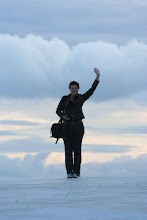At high Sun altitude (here 64°), the infralateral arc looks pretty much like a circumhorizon arc. While, however, the former one is caused by column crystals, oriented plates are responsible for the latter one. As the strong circumscribed halo was indicative of a column display, it must have been an infralateral arc in this case. In Vecsés, it was observable between 12:50 and 13:10, half an hour after Alex saw it in Mogyoród, some 20-25 km away.
Teljes méretű képek / Full-size images ( 1 - 2 )











2 comments:
By the infralateral arc your probably meant circumhorizon arc !
Btw nice 22 circumscribed halo.
We have got a halo week over here. Parry arcs, cza arcs, upper and lower Lowitz arcs...bright 22 degrees. Haven't got time to process these yet.
No, I did mean infralateral arc :) It seemed to be a column display, and at high Sun elevations the infra looks pretty much like a circumhorizon arc. Have a look at this page:
http://www.ursa.fi/halot/atlas/pylvas/pylv_p1.html
I've edited the posting, so now there's more explanation.
Congratulations on the Lowitz arcs. I've never seen one. Or at least I'm not sure :) But today I might have caught the fragment of an upper suncave Parry.
Post a Comment